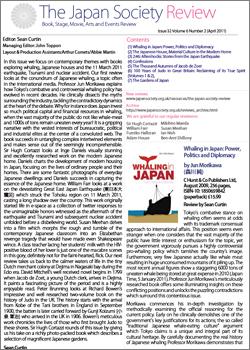Issue 32 (April 2011, Volume 6, Number 2)

In this issue we focus on contemporary themes with books exploring whaling, Japanese houses and the 11 March 2011 earthquake, Tsunami and nuclear accident.
Our first review looks at the conundrum of Japanese whaling, a topic often in the international media. Professor Jun Morikawa explains how Tokyo’s combative and controversial whaling policy has evolved in recent decades. He clinically dissects the myths surrounding the industry, tackling the contradictory dynamics at the heart of the debate. Why for instance does Japan invest so much political capital and financial resources in whaling, when the vast majority of the public do not like whale-meat and 1000s of tons remain uneaten every year? It is a gripping narrative with the vested interests of bureaucratic, political and industrial elites at the center of a convoluted web. The book succeeds in untangling complex intertwined elements and makes sense out of the seemingly incomprehensible.
Sir Hugh Cortazzi looks at Inge Daniels visually stunning and excellently researched work on the modern Japanese home. Daniels charts the development of modern housing in Japan, focusing on the lives of ordinary people and their homes. There are some fantastic photographs of everyday Japanese dwellings and Daniels succeeds in capturing the essence of the Japanese home.
William Farr looks at a work on the devastating Great East Japan Earthquake (東日本大 震災) which struck the Tohoku region on 11 March 2011, casting a long shadow over the country. This work originally started life in e-space as a collection of twitter responses to the unimaginable horrors witnessed as the aftermath of the earthquake and Tsunami and subsequent nuclear accident unfolded before a disbelieving world.
Susan Meehan delves into a film which morphs the rough and tumble of the contemporary Japanese classroom into an Elizabethan revenge tragedy that would have made even Shakespeare wince. A class teacher lacing her students’ milk with the HIV- positive blood of her lover is just one of the macabre scenes in this gory, definitely not for the faint-hearted, flick.
Our next review takes us back to the calmer waters of life in the tiny Dutch merchant colony at Dejima in Nagasaki bay during the Edo era. David Mitchell’s well received novel begins in 1799 when Jacob de Zoet, a young Dutch clerk, arrives in Dejima. It paints a fascinating picture of the period and is a highly enjoyable read. Peter Brunning looks at Richard Bowen’s impressive and well researched two-volume book on the history of Judo in the UK. The history starts with the arrival from Kobe of the Tani brothers in England in September 1900, the batten is later carried forward by Gunji Koizumi [小 泉 軍治] who arrived in the UK in 1906. Bowen’s meticulous work chronicles the lives of those who first brought Judo to these shores.
Sir Hugh Cortazzi rounds of this issue by giving us his take on a richly photo-packed book which describes a selection of magnificent Japanese gardens.
Contents
- Whaling in Japan: Power, Politics and Diplomacy
- The Japanese House, Material Culture in the Modern Home
- 2:46: Aftershocks: Stories from the Japan Earthquake
- Confessions
- The Thousand Autumns of Jacob de Zoet
- 100 Years of Judo in Great Britain: Reclaiming of Its True Spirit (Volumes 1 & 2)
- The Gardens of Japan
Contributors
Editor
Sean Curtin
Managing Editor
John Toppon
Layout & Production Assistants
Arthur Comets and Abbie Martin
Reviewers
Sean Curtin, Sir Hugh Cortazzi, William Farr, Susan Meehan and Peter Brunning

